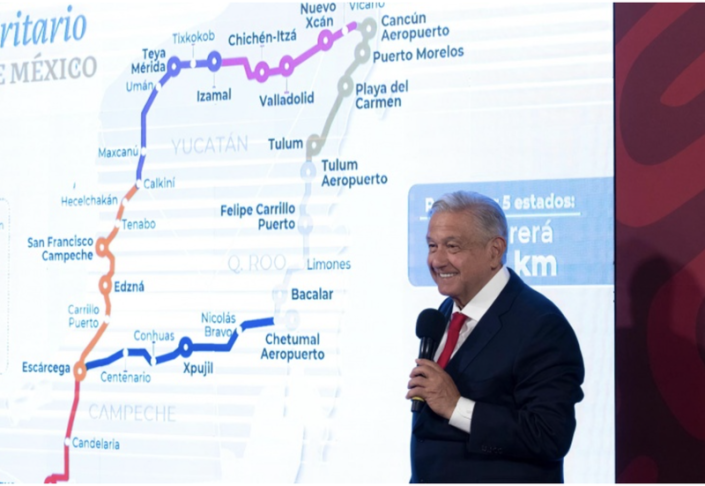Mexico’s government is building The Maya Train Project, which has nothing to do with the Maya People, but the fact is that this new train project is being developed at the expense of fragile ecosystems and indigenous artifacts, alarming the country’s environmentalists.
The train system, which is known as Tren Maya (or Maya Train), will cut through pristine environments that have barely changed in hundreds of years, Reuters reports. The more than 900 miles of tracks are going to carry both electric and diesel trains around the Yucatán Peninsula, connecting tourist hotspots like Cancún to the ancient Maya temples of Palenque and Chichen Itza.
The goal of this project is to bring tourism money to poorer towns across the peninsula, creating what President Andrés Manuel López Obrador (AMLO) described as opportunities for the region. “It will bring education, health, and housing actions to the communities where the train passes,” AMLO said in a press release last year. “It will bring infrastructure, culture, sports, internet connectivity, and economic development.”
But archaeologists and conservationists worry that those economic wins come at too high a cost for the Yucatán. Section 5, one of the routes in the proposed train system that will connect Cancún and Tulum, will come dangerously close to cenotes, Bloomberg reported. These are the beautiful, natural water-filled caverns with an opening in the ceiling. You’ve probably seen images of people swimming around in these lake caves on travel websites. Some experts worry that the roofs of the cenotes are not strong enough to withstand the weight of the trains that will travel over them or train rumbling that will come too close.

And despite being named in honor of the Maya people who have inhabited the peninsula for more than thousands of years, hurting the cenotes will hurt the indigenous people who still live there. The train route will cut through a town called Vida y Esperanza (life and hope), disrupting the daily routine in the area. The Maya people in that town rely on the water from the cenotes for everyday needs like bathing, the Associated Press reported.
The train’s construction might also damage pre-Hispanic relics. Construction crews working on the project have uncovered various Maya artifacts, like a tomb with ornate offerings and Maya cottages, the Washington Post reported. Archaeologists working on assessments since 2020 have reportedly been given unreasonable deadlines. In one stretch of the train construction, officials from the tourism development agency gave experts less than a month to excavate 37 miles of jungle. “They’re trying to do it overnight,” Antonio Benavides, an archaeologist who oversees the assessment in the state of Campeche, told the Washington Post. “There’s been no planning.”
The construction has also sparked conservation concerns. The Yucatán jaguar’s numbers have increased in recent years, a sign that conservation efforts in the region have worked, the New York Times reported. But experts worry that the train’s construction will reverse the progress made for the species in the region. The train route will also be close to the Calakmul Biosphere Reserve, according to Reuters. The region is the largest forest reserve in the country and a “Mixed World Heritage Site,” according to UNESCO.
The jungle is also home to Mexico’s jaguars. The iconic big cats were important to the Maya empire and were worshiped as deities for thousands of years. Deforestation and urban development shrank their hunting range, and many were killed by hunters after European colonialism reached the Americas. Their numbers increased from little over 4,000 jaguars in 2010 to 4,766 in 2018. The government agreed to create wildlife passes to allow animals to move around safely and to expand the reserve as a solution for having the train run so close to the area, the New York Times reported.
Since construction began in 2020, there’s been major pushback. In 2020, opponents of the train project were able to get a temporary injunction against the project, pausing it for a bit. But the government resumed construction in 2021, per the New York Times. Other elected officials have tried to bring in more outside expert judgment on the project. Mexican official Kenia López Rabadán sent a letter to Frédéric Vacheron, a UNESCO representative in Mexico, asking the agency to intervene in the project, El Universal reported. In a press conference last year, she acknowledged the importance of economic development in the region, but not at the expense of the peninsula’s archaeological history or ecological wellbeing. The train is scheduled to be completed by the end of this year, according to Reuters.
Tourism in general has negative impacts on ecosystems all over the world. Unlike in Mexico, elected officials in other popular vacation destinations around the world are setting up quotas to protect the local environment. In hopes of combatting huge crowds and the litter, they leave behind.
Source: Excelsior





